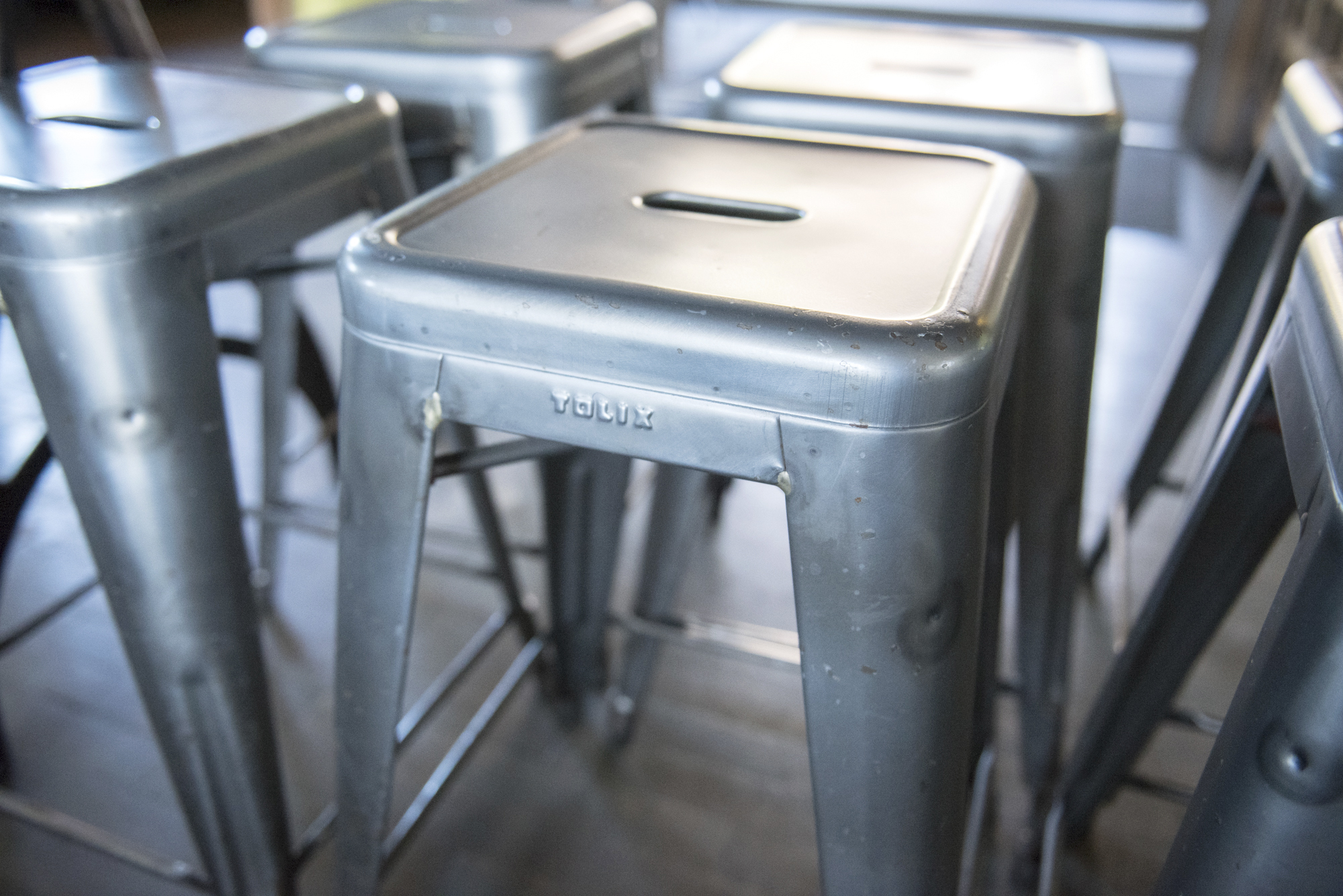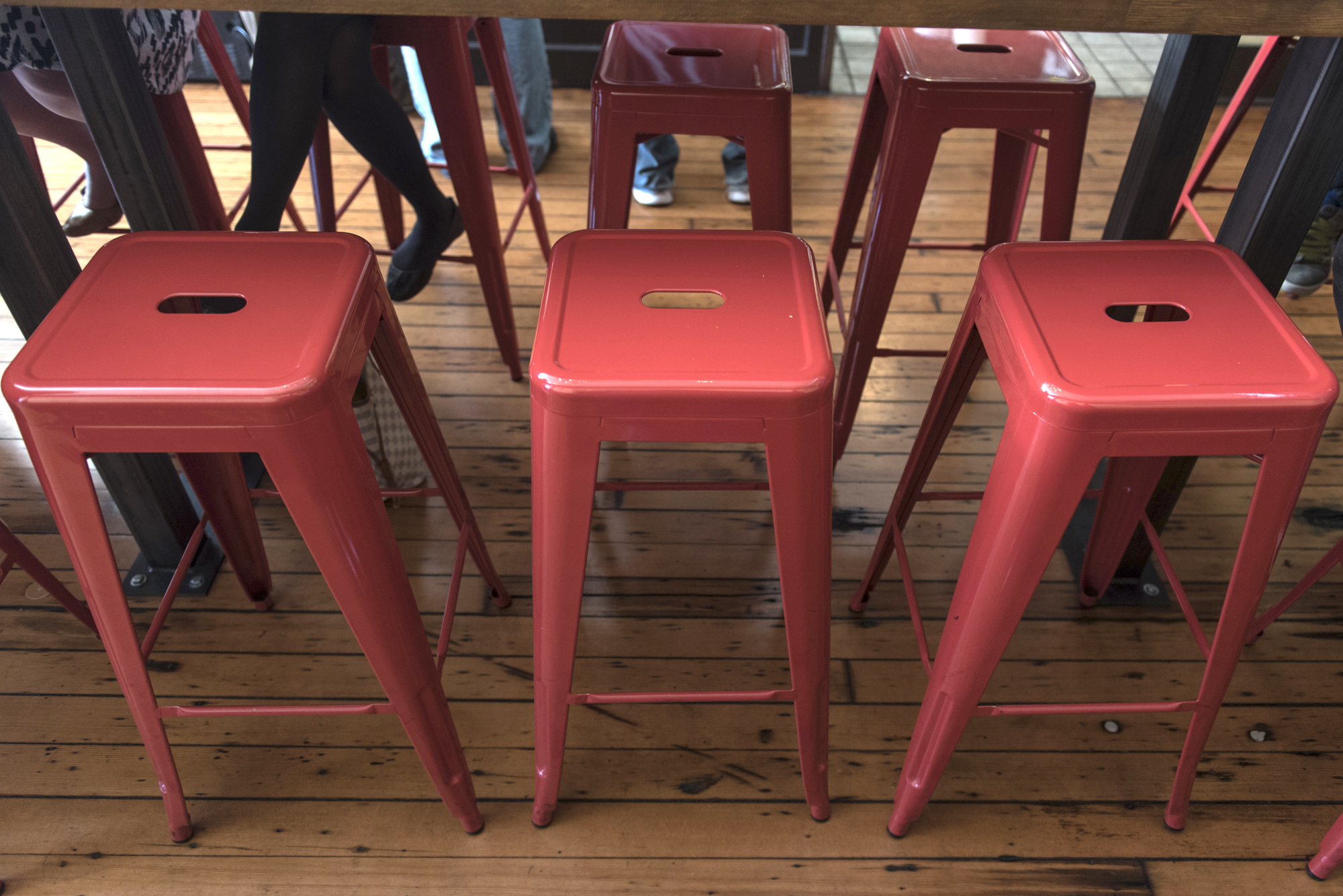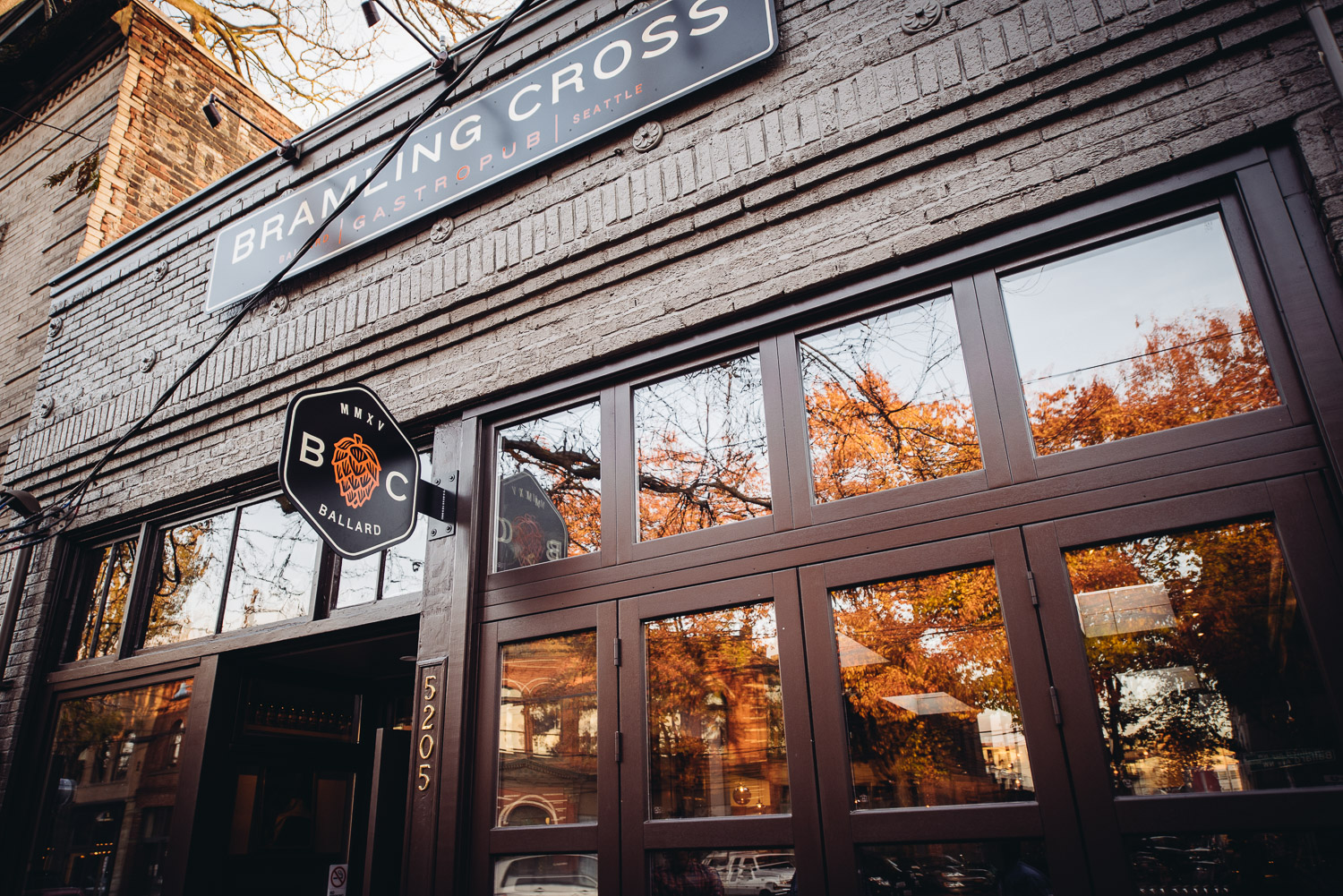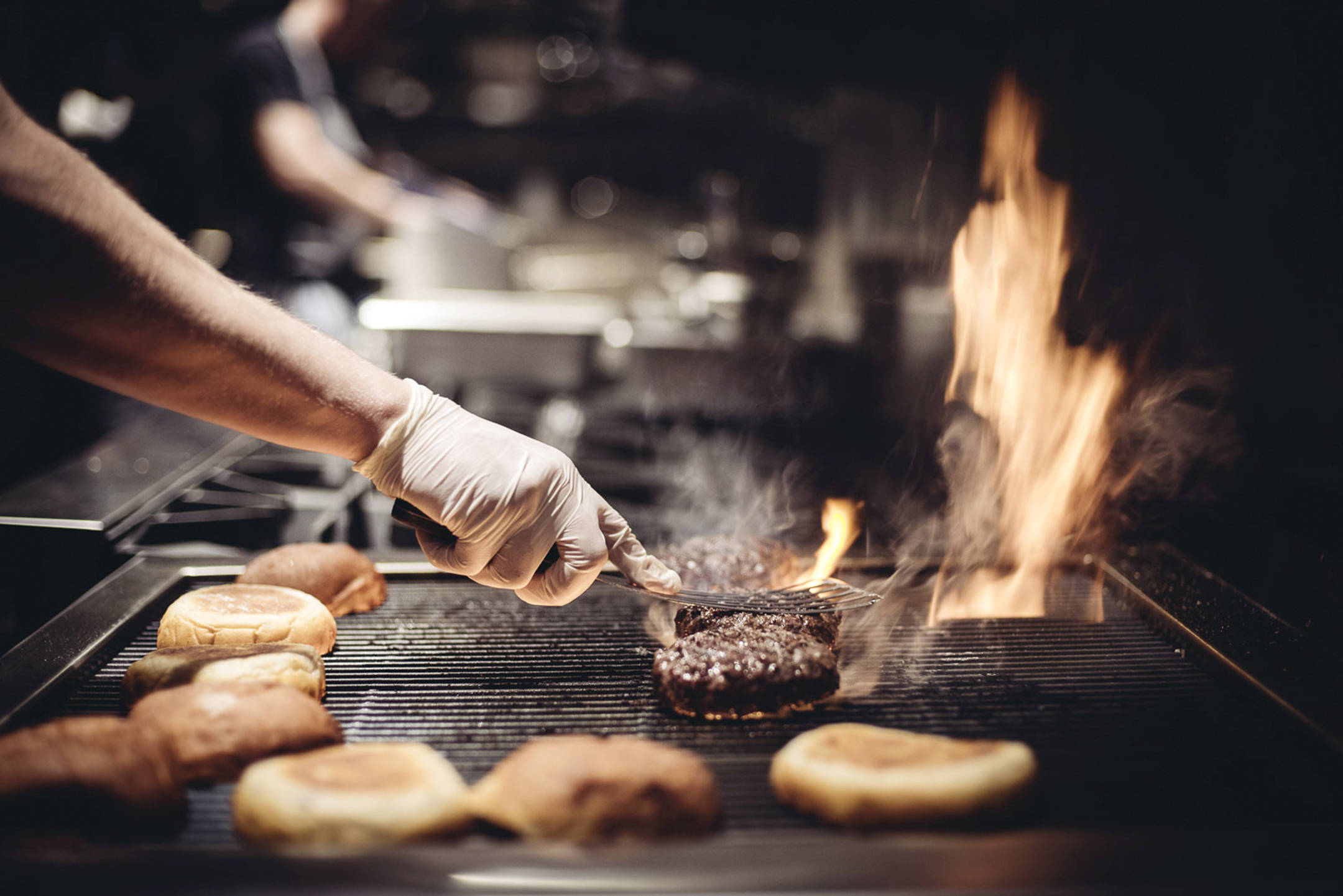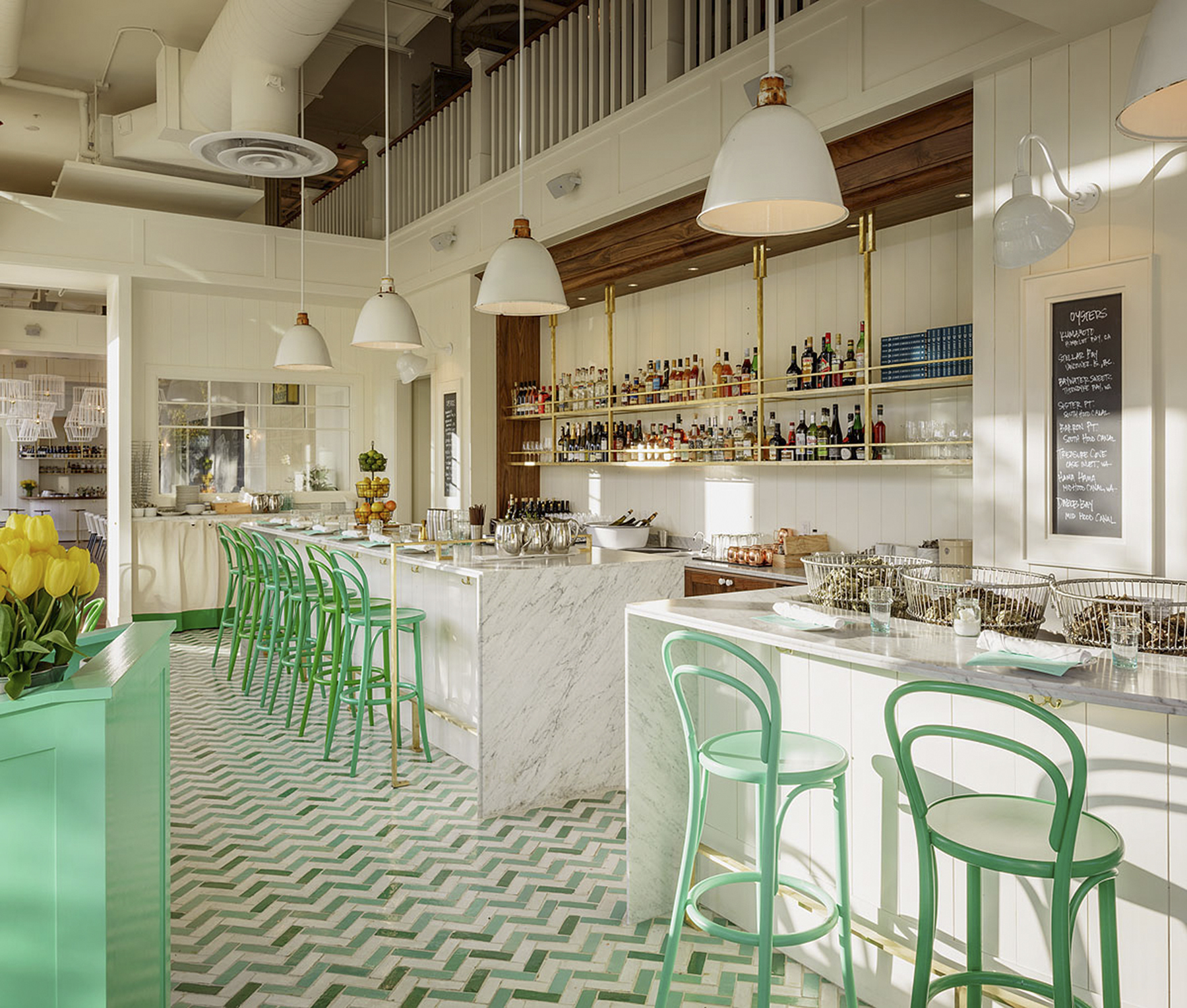About a year ago I was scouring the Internet in search of bar stools for my kitchen. I had two primary criteria: I wanted something with a retro look in a bright color. On overstock.com, up popped a pair of stools that immediately appealed to me. Labeled “Tabouret 24-inch Tangerine Metal Counter Stools,” they had clean lines, foot rests, legs that protruded at a slight angle, and a seat with a three-inch rectangular cut-out in the center. A set of two cost $89. I bought four, they looked fabulous at my kitchen’s island, and I basically forgot about them.
Then I started seeing them at just about every stylish Seattle restaurant or bar—not in the orange I chose, but in black or gunmetal gray. Stoneburner, Tray Kitchen, Manolin, Delancey, Il Corvo, Bitterroot, Pizzeria Gabbiano: The list goes on and on. Why the sudden proliferation of this particular counter stool—and where did it come from?
A call to Atelier Drome, a local architecture firm that designs many top restaurants in town, confirmed that I wasn’t crazy. They too had been seeing the stools a lot lately. Why? “Honestly, because they’re durable,” says Michelle Linden, principal architect at the firm. She also attributes their ubiquity to “all these design magazines that, instead of making things more unique, actually result in them becoming more common. At least three or four restaurateurs have showed me their ‘inspiration’ photo, and it’s exactly the same—something Swedish-looking.” But the chairs, she told me, are in fact based on a French design from 1934: the Marais line of chairs by Tolix, including the omnipresent Marais Counter Stool.
Tolix is still around, and authentic chairs are available through Design Within Reach. When I call the company’s Seattle outpost, staffer Theresa Crim tells me that DWR has been the “exclusive U.S. retailers” of genuine Tolix chairs for a year now (though you can still get them from a handful of smaller retailers, like Sundance, as in Robert Redford’s company). DWR works directly with Tolix, a company of only 70 employees that still makes the stools at their factory in Burgundy. (You can get the authentic stools in custom colors and even with a shimmer, starting at $305.)
Designer Xavier Pauchard’s stool became synonymous with Paris cafe culture in the ’30s. The original chair line was made in gunmetal gray—after the war, it is rumored, from the massive amount of scrap metal left over, Crim says. And those rectangular holes in the seats are more than just a design whim—or, as I thought, an easy way to pick the stool up: They allow water to drain off, since the stools were often used at outdoor cafes.
The stools are of course stackable and very durable. “You can really throw it around and they don’t look bad,” says Crim. Linden agrees, citing that metal works a lot better in restaurants because wood breaks easily. “Aside from a custom steel chair, there’s not a ton of options.”
“They also have that shabby-chic French thing, but with a refined element to them as well,” says Crim—refined and rugged enough to find a home even on the decks of the SS Normandie, the transatlantic ocean liner built in 1935 and known for its lavish Art Deco interiors. The chairs may have found more fans in 2011 when British lingerie company Agent Provocateur ran an ad campaign featuring an erotically clad model posed in a Tolix Marais chair. The chairs’ artful appeal goes beyond ad execs, though; a few can be found in collections at New York’s Museum of Modern Art and Paris’ Centre Pompidou.
But at $305 a pop and a need for dozens of them, it would be a stretch for most restaurants to carry the real McCoy—especially when imitations like the ones I own are all over the web and, according to many restaurant designers, hold up well. Stoneburner designer Deming Maclise says, “The look of the Tolix barstools are great because they can work in a lot of different design settings. They are very chameleon-like in that way. They can offer a bit of an industrial look without driving the design. I like using the copies, though, because you can get a very similar look at a fraction of the price.”
That unsurprising reasoning is also what drove Mike Easton to buy knockoffs four years ago for Il Corvo, and now for Pizzeria Gabbiano (in orange!). Where did he stumble on them? At Seattle’s Diller Room, where owner Rob Wilson says he first saw the famous stools in Australia. He had a client there, “a really cool, eccentric French guy,” who would bring all kinds of interesting stuff back from France, among them these stools “in a beautiful navy blue.” He kept them in mind and found the cheaper counterparts on overstock.com, as I did, in 2009, and had seat pads custom-made for them for extra comfort. “They’re very sturdy and the design is superior,” Wilson says. “Recently we thought about doing something else [for a room they were updating]. We briefly discussed changing all the bar stools, and then said, ‘No, that’s the one.’ ”
Googling “Tolix chairs” brings up a list of inspired versions (mostly made in China) from a slew of companies, identified often as “Tolix-style,” or in one listing as “Talix.” (It’s not authentic if it doesn’t have the trademark sign.) The critical difference between a Tolix and these replicas, according to Design Within Reach’s corporate PR representative, Kimberly Phillips, is the weld. On a Tolix, “everything that holds the chair together is welded”—the foot rest to the legs, say, or the base to the seat—with signature brass solder rather than lower cost spot welding. There’s no screws holding it together, as is the case with my Tabouret stools at home, bur rather traditional rivets.
To understand how else they differ, you need to know a bit about steel. While most of the replicas cite “100 percent steel” or “Metal Steel,” a closer look at the product information will often identify it as “cold rolled steel,” the most common and affordable type—which can rust over time. By contrast, Tolix chairs are galvanized sheet steel, meaning they’ve been coated with zinc to add rust and corrosion resistance. The company refers to the steel as “automotive,” which is extremely high-strength and allows for greater pliability. There’s also a difference in finish. For the gunmetal-gray chairs, for instance, Tolix employ a labor-intensive buffing process directly to the raw steel, while fakes tend to use gray paint to try and ape the buffed steel finish.
Crim says she knows of only one restaurant in town with authentic Tolix: Oddfellows. So go check for yourself: Just look for an embossed “Tolix” logo on it (it was started for the 2006 models, with “made in France” added in 2011). Given owner Linda Derschang’s penchant for bohemian style and her reputation as a tastemaker in Capitol Hill’s nightlife scene, I wasn’t surprised. A call to Oddfellows confirmed that they indeed have the real deal, in gunmetal gray.
Derschang saw them at a lot of cafes in France about a year after the restaurant opened, in 2010. She says she decided to buy them for her rustic-yet-chic cafe and bar because “it’s hard to find something that’s both stylish and comfortable.” She, however, has the Marais “A” chair, with a back. Why did she splurge on the authentic? She “loves mixing high-end and low-end together, and so we were either going to buy high-quality new Tolix chairs or look for some vintage ones rather than buying knockoffs.” She also adds that at the time, Tolix chairs were not as popular as they are now, so imitations were not as common. (She bought hers from Sundance for $295 each. They’ve replaced about half of them over the past five years.)
I couldn’t stop thinking, however, that I’d seen the originals elsewhere in Seattle. After running through my recent dining list, it finally occurred to me: Bottlehouse. Sure enough, the Madrona spot does have black and gray stools with the Tolix stamp. Owner Henri Schock, whose wife Soni does interior design for some restaurateurs, including Derschang and Maria Hines, says she bought vintage ones and refabricated them (they were beat-up to the point that customers didn’t want to sit on them). However, despite their telltale logo, the reseller she bought them from couldn’t verify that they were in fact authentic.
So was Derschang the first restaurant owner to have the stools (genuine or otherwise) in Seattle? Possibly, but maybe not. Delancey also has the real stools, as confirmed by owner Brandon Pettit, which they bought for their 2009 opening. But wait. A conversation with a friend led me finally to Susan Kaufman, owner of Serafina and Cicchetti. Sure enough, she bought the gunmetal-gray Tolix counter stools from British retailer Terence Conran in 2008 for Cicchetti—after seeing them in France and at New York restaurant Public—two years before Derschang bought her authentics and one year before Delancey opened. Because she sourced them from Europe, she said she paid “thousands,” mostly due to shipping costs. She has not had to replace a single one, however.
And so the mystery of the stool has seemingly been solved, at least here in Seattle. How much longer will the trend continue? It’s hard to say, but based on their durability and aesthetic appeal—and the low cost of imitations—I’m betting our butts will be sitting on them for the foreseeable future.
